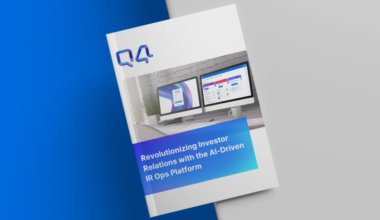Markets don’t wait for quarterly reports anymore.
Investment decisions are unfolding in microseconds rather than months. Investors constantly recalibrate positions based on emerging news, competitive movements, and nascent market trends, often well before these shifts appear in conventional metrics.
Static journey maps, traditionally anchored to quarterly milestones, now represent just a fraction of the investor journey, and relying on them leaves IR teams exposed. It limits visibility into how sentiment is developing, where attention is drifting, and what issues are starting to matter before they’re voiced directly. They need a sophisticated sensing capability that overcomes these limitations.
This isn’t just about being faster, it’s about fundamentally reimagining how we map and respond to the investor journey. A change in tone, a drop-off in content engagement, or a portfolio reshuffle might be the only early clues. If your map can’t detect that, you risk falling behind.
Investor Journey 2.0 reflects a new standard—a dynamic, signal-driven approach that replaces static snapshots with real-time insight and forward-looking visibility. It’s not about tracking the past. It’s about sensing the present and acting on what’s likely to come next.
Signals: The New Currency of Investor Insight
Signals often surface quietly. An uptick in traffic to your ESG disclosures. Investor reactions to a competitor’s earnings that hint at broader sentiment shifts. A question that cuts straight to risk. A drop in meeting engagement that no one flags but everyone feels. These aren’t captured in a spreadsheet or logged neatly in a CRM. But they matter, because they’re often the first signs that something’s changed.
The best insight often comes from what doesn’t stand out until you step back and connect the dots. When interpreted as part of a living map, signals allow teams to move beyond looking back. They help answer harder, more strategic questions: What’s changing beneath the surface? Where is sentiment building momentum? Where might confidence be softening? What narratives are resonating, and which ones are starting to fray?
Traditional indicators like post-event feedback or trading volumes arrive after the moment has passed. They confirm what already happened but offer little guidance on what’s taking shape. Signals, by contrast, reveal intent as it’s forming: through patterns in digital engagement, the nature of inbound questions, shifting interest in specific disclosures, or subtle changes in meeting dynamics.
Seen in isolation, these cues are easy to overlook. But together, they offer a more immediate, more accurate view of where investors are headed and what matters most to them right now.
Adaptive Mapping: From Retrospective to Predictive
A dynamic, signal-driven approach builds adaptive feedback loops enabling IR teams to detect early warning signs, personalize engagement based on real-time investor needs, and continuously refine strategy, mirroring leading customer-centric organizations.
Here’s how leading IR teams are driving this:
Turning Activity Into Insight
- Behavioral journey mapping: Strategic teams leverage advanced analytics to visualize the entire investor experience across digital and in-person channels, identifying engagement patterns and friction points to optimize communications at every stage.
- Sentiment pulse monitoring: High-impact teams leverage AI-driven monitoring to scan financial news, social media, and investor forums to capture real-time perception shifts, allowing for proactive adjustments before concerns escalate.
- Engagement maps: Using interaction data from reports and web materials, IR teams identify which sections capture the most attention and use these insights to refine content structure and prioritize what matters most to their audience.
- Trigger-based alerts: Proactive IR teams use real-time alerts to stay ahead of high-intent investor actions, such as large share movements or spikes in document downloads, instantly notifying teams of engagement opportunities that require immediate follow-up.
Messaging That Resonates
- Personalized messaging: Using AI-driven insights, teams tailor communications to reflect investor segment priorities and recent interactions, ensuring messages are relevant and resonate with current concerns.
- Narrative framing aligned with investor values: Investor-centric teams craft messages that connect corporate strategy to specific investor values, whether focused on growth, sustainability, or governance. This approach builds trust and emotional engagement, critical for long-term relationships.
- Adaptive content formats: Recognizing diverse investor preferences, strategic teams vary delivery through written reports, video briefings, infographics, and interactive dashboards, increasing accessibility and comprehension across different learning styles.
- Continuous message testing and refinement: Forward-thinking teams employ A/B testing and feedback analysis to evaluate effectiveness, iterating content based on engagement metrics to ensure messaging evolves with investor expectations.
Orchestrated Outreach That Lands
- Optimizing timing through data-driven insights: Leading IR teams analyze real-time investor behavior and context to identify the most receptive moments for communication, aligning outreach with decision-making rhythms rather than fixed calendars.
- Multi-channel engagement for broader reach: Effective outreach leverages personalized emails, virtual events, social media, investor portals, and AI-powered chatbots tailored to investor preferences, increasing both reach and engagement effectiveness.
- AI-powered automation with human oversight: Modern teams deploy AI to intelligently orchestrate engagement around critical events while handling routine queries in the background, allowing IR professionals to focus on high-value, relationship-driven conversations.
- Scenario-based outreach planning: Adaptive teams prepare for various market scenarios by pre-mapping outreach strategies tied to specific signals like earnings surprises or activist interest, enabling rapid, coordinated responses that maintain investor confidence.
Intelligence-Led Targeting
- High-priority investor detection: Modern IR teams are moving beyond static profiles and generic investor lists. By combining behavioral signals, transaction patterns, and sentiment trends, they can identify high-priority investors earlier: those most likely to shift positions, seek engagement, or influence market perception.
- Investor intent discovery: Topic engagement, tone shifts, and content preferences offer early clues into what different investors care about most. This intelligence supports sharper prioritization, helping teams focus attention on investors most likely to engage, reallocate, or influence peer sentiment.
- Motivation-aware prioritization: By interpreting signals that reflect evolving investor motivations, such as values-based engagement or reaction to competitor news, teams are better equipped to align internal narratives with external expectations. This makes targeting not just more precise, but more strategic.
- Proactive targeting through forecasting: With predictive capabilities, AI can flag which investor groups are likely to shift positions or require additional engagement, allowing IR to get ahead of the conversation before it even begins.
- ESG perception tracking: By monitoring sustainability inquiries, ratings changes, and investor feedback, modern IR leaders measure how ESG narratives are received and where expectations may be evolving.
Redefining IR Performance
- Shareholder composition metrics: Progressive IR practitioners track changes in the investor base, institutional-retail mix, and retention rates to assess IR’s impact on maintaining and attracting key holders.
- Engagement quality indicators: By moving beyond volume-based metrics to assess the depth and relevance of interactions, data-driven teams are analyzing meeting participation, follow-up quality, and relationship progression over time.
- Voting pattern analysis: Proactive IR teams review proxy outcomes and shifts in shareholder support to assess alignment with key proposals and identify where messaging may need to rebuild trust.
- Digital engagement depth: Insight-led IR professionals track how investors interact with web pages, documents, and disclosures to pinpoint what resonates and where engagement drops off.
- ESG perception tracking: By monitoring sustainability inquiries, ratings changes, and investor feedback, modern IR leaders measure how ESG narratives are received and where expectations may be evolving.
It’s Time to See What You’ve Been Missing
Sometimes the clearest signals come not from what’s said, but from where investors choose to linger or where they quietly drift away. When priorities shift and attention moves, being able to notice and interpret that early can make all the difference.
Modern IR isn’t just about reporting what happened. It’s about staying close to what’s changing, interpreting signals in real time, and showing up with relevance when it matters most. It demands tools and thinking that help teams stay tuned to real-time investor signals and respond with precision. As the shift toward dynamic, signal-led engagement accelerates, those equipped to move early will be best positioned to build trust, mitigate risk, and create long-term value.
Q4 is introducing AI-powered capabilities to help IR teams take the first steps, translating signals into strategy and giving visibility to what’s ahead.


